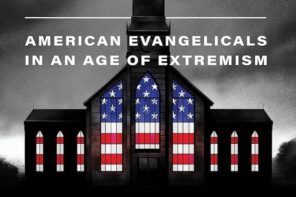In recent weeks, watching evangelical white preachers, pastors, and Christian schools post black squares on varying social media platforms as a sign of solidarity with the Black Lives Matter movement has been a slap in the face—especially for me as a Black woman.
During my childhood and early adolescent years, I had the misfortune of attending several evangelical white Christian schools. As I neared the 8th grade, the last school where I was enrolled (which for the record had a quota of how many black students it would accept) proved to be the most damaging to my psyche.
For the subsequent three years, in a million PTSD-inducing ways, I would be regularly reminded that my Black life was either worth very little or that it was, in no uncertain terms, altogether “sinful.”
Obviously it wasn’t always the overt-racism that communicated such idiocy, like being called a nigger to my face by white men who claimed to have a closer relationship with God than I did. (Although for the record there were countless instances of that too.)
But most times, and perhaps more scarring, there were countless microaggressions, such as auditioning for the church play only to be told that I likely wouldn’t get it, while throwing in a comment pertaining to the size of my lips. Or putting my name on the sign-up sheet for the school formal to find that someone had already written ‘Shaquaneesha’ in place of where my name might have been.
But kids will be kids, right? Wrong.
Kids will be products of what their parents instill in them at home.
And in my case, I went to school with a lot of white Christian children whose white Christian parents used scripture to further the narrative about anyone with my complexion that whiteness meant superiority—even in God’s eyes.
Weekly chapel services were always held under the authority of preachers who never looked like me, and yet somehow each sermon had a tendency to circle back and attack the people who did. Countless sermons juxtaposed the devil’s music—which happened to include only Black forms of artistic expression such as Rap or Hip-Hop—with Country and Top-40 which, we were taught, were wholesome and appropriate.
It was never lost on me that Rock n’ Roll was God’s favorite music, that straight blonde hair was His select style, and that Liberty or Bob Jones University were his schools of choice.
My blackness seemed nothing more than a speck on the pristine framework of white evangelicalism. My skin tone was something to be tolerated as a transgression that I had chosen or been cursed with. If it were “accepted” at all, it would only be with an ethos that loudly declared, You don’t deserve to be here, but we’ve conferred with Jesus and have decided to allow it anyway.
It’s because of this that watching those same teachers, pastors, former students and the like develop a sudden interest in posting black squares or release statements to the effect that they “stand with their black brothers and sisters in Christ” is at best, laughable. At worst it stirs up old trauma that I and others who share my experience have spent small fortunes in therapy and other personal work to undo. And in some sad sense, we’re the fortunate ones. Others have unintentionally internalized this hatred which manifested later in a variety of self-destructive behaviors. It’s the price so many have had to pay for the seeds of self-hatred that were sown early on.
Few things are more infuriating than scrolling through countless blacked-out squares on Instagram or seeing Facebook posts written by the very leaders who’ve managed to find the audacity to pat themselves on the back declaring how glad they are that they “weren’t raised to see color but instead to see the heart of Jesus.”
Both a bald-faced lie and a slap in my Black face.
For me personally, while I do remain a devout Christian, the way I see Jesus differs dramatically from the ultra-conservative, right-wing, I-don’t-see-color deity I spent a good part of my childhood learning about in school. And, no pun intended, but thank God for that.
However, if white evangelicals, Christian schools, or white pastors really want to show solidarity, a black square will never—and I mean, never—be enough. Not while they continue to promote leaders, policies, and theories that support white supremacy in the nation and encourage the idea that the body of Christ is segregated by race and class.
To people of color who have spent centuries being shunned or diminished by white evangelicals, anything less than acknowledgment, and changed behavior, specifically from Bible-toting white men who’ve manipulated scriptural teachings in order to keep Black people in both literal and proverbial chains, will be as fake as it is antagonistic.
The acknowledgment that Black lives matter must be more than a moment in history, not a marketing ploy or an opportunity for fraudulent inclusivity via corporate statements.
Keep that.
The dismantling of white supremacy has to extend far beyond “Blackout Tuesday” or it will never work.
So what does genuine change look like?
Truthfully, no Black person should ever be expected to describe in totality the ways in which they wish to be treated fairly. It’s exhausting to explain and tiring to unpack. After all, we don’t exactly have a racism-free America to compare it to since, sadly, such a nation has never existed. Besides, how does one person teach another to treat human beings like human beings?
But I can tell you without a doubt that a start would have been not being able to count on one hand the number of Black children in my entire Christian school student-body. Do Black educators only exist in public schools? Of course not. Why then couldn’t we find more Black scholars to employ when it came to teaching children?
I can tell you that I’ll recognize change as genuine when white preachers and ministers stop using Bible verses to pacify their white congregants by amplifying comfortable statements like, “God loves all of His children equally.” Does He? Sure. But it’s certainly not reflective in evangelical teachings. Fix that.
I can tell you that Christo-centric Instagram pages would be wise to not play the safe side by clinging to “Christ would want us to unite…” jargon. No. If unity is truly the end goal, it cannot come without first the acknowledgment of wrongdoing and the understanding that peace does not equal passivity. Choose a side.
White churches such as Hillsong and Bethel Music would do well to incorporate the Black contribution of gospel music to their worship services instead of segregating the art forms. How do your Black parishioners feel? Included? Celebrated? Appreciated? Probably not.
Until white evangelicals are willing to rework the entire framework of their teachings, they can ‘Blackout Day’ till they’re blue in the face, but their overall message will remain loud and clear: Black people are a stain. A moment, only to be tolerated but never fully accepted.
And the only square that will prove to matter will be the one at which we started: Square one, where the little Black girl in a Christian school is trying to figure out why her braids “don’t meet dress-code” and a little Black boy has been told that his locs are unprofessional.
For every joke about thick lips, ghetto names or dark skin; for the Nigerian student who, my Bible teacher remarked (with a slight chuckle), was “fresh off the boat”; and for countless other moments like this, a black square without consistent, follow-up action, simply ain’t gonna cut it.





